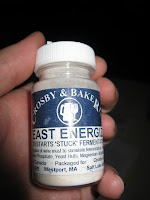What is bulk aging and why do it? Well, bulk aging is allowing the wine to age in a carboy instead of in bottles. You do this for a couple of reasons. I will quote Winemaker magazine's "Wine Wizard" below:
The general purpose of bulk aging is to let the wine do what I call “finding itself” post-fermentation, which entails, physiologically and chemically, a couple of important things. First of all, a wine needs to 100% complete its primary fermentation. Any wine that is still going through these initial fermentation stages, in my opinion, is not finished wine and will lead to fizziness and cloudiness in the bottle (if bottled too early). A wine also must lose the carbon dioxide it might have retained from its fermentations and it has to have enough time to settle out its natural sediments (“lees”). If you’re so inclined, you could go through other steps like filtration or cold stabilization, but these are just icing on the cake. After a wine is inactive and settled out, the main determinant of when to bottle should be taste. Gutsy red wines like yours may need 12 months in the barrel or carboy to mellow out their harsh tannins whereas some delicate, white wines can technically be bottled as soon as they fall bright.
I think this is a pretty good explanation. Also, you must consider that purely from an surface area contacting oxygen standpoint, the bulk aging will be at much less risk of oxidization. There's only about 2" of surface area in the entire batch whereas each bottle will have an inch or so of surface area where it is contacting oxygen.
Good enough for me.
On to the pictures!
Not quite as much sediment left here as you can see. The only thing I added was 1/4tsp of K-Meta to aid in the bulk aging. I topped it with a bung and airlock only because I can't find my solid bung (no hole in the stopper) which I'm going to grab tomorrow from Axis Natural Foods.
The wine smells absolutely delicious, by the way. The oak cubes were well soaked and I can get that nice hint of oak. A tiny bit of topping up was needed, so I used what I carefully sifted off of the lees when I racked the last time (which I placed in an airtight container in the fridge for this very reason.)
Skeeter Pee!
Time to stabilize the skeeter pee. It has a faint sulfur smell (which is not uncommon with lemon wines) which I'm going to take care of by "splash racking" which simply means letting the wine hit the side of the container and splash in, aerating it and helping to disburse the sulfur dioxide. Normally, you don't want to splash rack because oxygen in your wine is bad, but I'm about to put this all under airlock so it will be totally fine.
Splash racking temporarily to the bucket so I can degas as well as clean the carboy to put the skeeter pee back in (it's my only 5GAL carboy.) Notice the tube is up in the air and the wine is foaming as it hits.
And that's that, now time to degas- splash racking helps degas, by the way and it also remains important to keep the wine warm. The room was a bit cooler than I would have liked, but I went ahead anyway.
And then it was time to add the following: K-Meta (1/2tsp) K-Sorbate (2 1/2 tsp) and dissolve Sparkolloid (a clearing agent) in boiling water and add all of that in order to a) stop fermentation and b) drop out the remaining sediment to prepare for bottling:
And finally, after cleaning and sanitizing the carboy it's time to rack the wine back into the carboy and add a stopper to keep out the oxygen:
That's all for day 35! I'm going to let the red wine age for about 3-6 months (haven't decided yet) in the carboy. After that it will be on to bottling. The skeeter pee will be done within the month and ready to be bottled.
Until next time, thanks for reading.
































